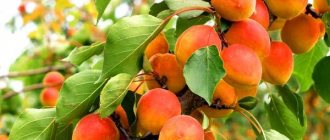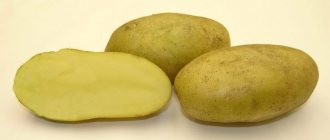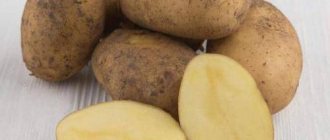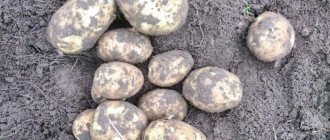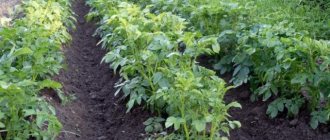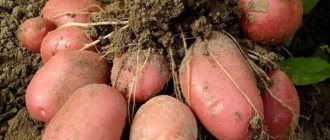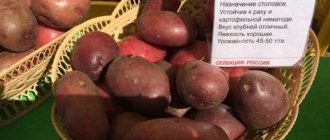Spring planting of potatoes has long been part of our mentality. Even the most ardent opponents of such a dacha pastime sooner or later think about allocating a small bed for potatoes. After all, no matter how good the purchased potatoes are, your own harvest will always be better. Moreover, modern selection has provided summer residents with a large selection of different varieties of this vegetable. Below we will talk about such a variety as Bellarosa.
Description of the variety
Early potato Bellarosa (Solanum tuberosum) is classified as a modern breeding variety. It was bred and patented in the German city of Luneburg, it was entered into the Ukrainian state register in 2004, and the Russian one in 2006. The variety gained popularity due to its taste, unpretentiousness to growing conditions and high yield.
On a note! Bellarosa does not change color during heat treatment. Dishes made from it turn out appetizing and beautiful.
| Characteristic name | Description |
| Consumer qualities | The taste of Bellarosa potatoes is rich and suitable for any culinary dish. |
| Appearance | Tubers are medium and large in size, rounded oval in shape with white-yellow pulp in a red dense peel with lilac sprout cavities |
| Weight and number of tubers in the bush |
|
| Maximum yield | Up to 550 centners per hectare |
| Soil requirements | Grows on any soil, suitable for cultivation on the territory of the Republic of Belarus, Ukraine, in the Central, Volga-Vyatka, Ural, North-Western regions of the Russian Federation |
| Required climatic conditions | Bellarosa can withstand dry conditions, temperature changes, prolonged rains and thunderstorms |
| Starchiness | 12,5-15,8% |
| Type / purpose | For use in cooking, belongs to type B (slightly crumbly), has a rating of 6 points out of 9 on a scale of professional tasters |
| Ripening time | 45-60 days from the moment of germination |
| Features of cultivation | Standard agricultural technology is suitable, the use of metribuzin-based spraying agents is not advisable, the application of organic and mineral fertilizers is recommended |
| Not susceptible to some diseases and viruses |
|
| Presentation and keeping quality | Suitable for transportation, long-term storage |
Top dressing
Any early potato variety requires fertilizers containing magnesium. This is especially true for those bushes that grow on soils with a lot of sand. Usually dolomite flour is used. In addition, it is recommended to use the following fertilizers:
- After the first symptoms appear, it is recommended to use infusions made from manure or chicken droppings.
- Before flowering, potatoes are fertilized with urea or a solution of potassium sulfate and ash.
- During flowering, it is best to make a composition of mullein and superphosphate.
Fertilizing is applied only after thoroughly watering the bushes. If you add them to dry soil, the root system can be burned.
Advantages and disadvantages
Bellarosa potatoes are distinguished by one feature, which some gardeners consider a disadvantage: numerous tubers ripen in a non-compact manner, far from the growing point. When digging by hand, this feature causes inconvenience: the fruits are placed on the tip of the shovel, cut, and go unnoticed.
The disadvantage is susceptibility to attack by wireworms and the Colorado potato beetle. Preventive treatment of planting material with special means before sowing helps to avoid pest invasion.
Bellarosa potatoes have many advantages:
- good yield, especially when applying fertilizers and sufficient watering;
- resistance to many fungi, viruses, physiological diseases;
- unpretentiousness to growing conditions:
- grows in poor and mineral-rich soil;
- tolerates heat and rain-waterlogged soil;
- withstands cold weather.
- high productivity even in the absence of an irrigation system (this quality is especially important if there is no constant opportunity to monitor the potato plantation);
- long-term storage and transportability due to the thick peel, not subject to punctures and peeling.
On a note. Early varieties are intended for food consumption; they are not grown for the purpose of storing for the winter. However, according to experts, the Bellarosa potato variety can be left for storage. Of the total mass of the harvest, only 4-6% of the tubers are discarded, the rest retain their density, do not dry out and do not lose their taste.
Reviews from gardeners with experience
In addition to the fact that this variety is grown in various ways, we should not omit the fact that the country is huge, and depending on the region and climate, the growing conditions also change. Let's consider reviews about the Bella Rose variety from gardeners from various regions.
Vasily Kramarov, Volgograd
“Bela Rosa” is planted over large areas with the help of a tractor. The choice fell on this variety a long time ago because it practically does not get sick. If you carry out simple manipulations to combat the Colorado potato beetle and other insects, the problems will disappear by themselves. We grow potatoes for sale. The cost is low, and it sells very well due to the fact that we love pink potatoes. It's really very tasty.
Lyubov Korolenko, Alushta
Having retired, I enjoy growing early potatoes. It is often possible to grow two crops at once in a season. “Bella Rose” is very popular among us; it is quite popular among all my neighbors. The quality of the potatoes is excellent; we also like to plant Riviera. Why I love the Bella Rosa variety is that it is unpretentious to grow. The bushes are tall and the flowers are rare. I fertilize only in the form of ash, remove weeds and loosen the soil with a hoe - that’s all the care. But the harvest never failed.
Another review of many potato varieties, including Bella Rose, can be seen in the video:
Planting and care
According to consumer reviews, the Bellarosa variety is planted in various ways:
- into the ground,
- straw,
- on the ridges,
- into the holes.
At any planting, potatoes give excellent germination.
A good result is provided by the soil after buckwheat, oats, and mustard. Pre-planting these crops before potatoes enriches the soil with the necessary nutrients.
Preparing for landing
Bellarosa is planted in the ground at the end of April, if weather conditions permit (later in the northern regions). Before sowing, the tubers are allowed to germinate, this speeds up the process of shoot emergence. To do this, at the end of March (about 2 weeks before planting) preparatory measures are carried out:
- tubers are inspected for the presence of eyes (rotten, shriveled, moldy specimens are not used);
- the selected material is placed in a dry room with a temperature not lower than 13-15 degrees Celsius;
- polyethylene is laid out on the floor, potatoes are distributed on it in one layer;
- a vitamin-prophylactic biologically active solution is diluted in water (to accelerate growth, increase immunity, protect against pests) and evenly spray the planting material;
- When the sprouts have reached 2-4 cm, the potatoes are planted.
On a note. Spraying tubers is not a mandatory procedure, but doing it can make the growing process easier. At the same time, you don’t have to worry about treating a grown potato plantation with insecticides due to damage by Colorado potato beetle larvae.
Landing
You can visually determine the readiness of the soil for planting:
- there should be no snow crust on the surface;
- the humidity level should not be too high (your feet will not get stuck in the mud);
- when compressed, the earthen lump crumbles into lumps (but does not turn into dust).
The hole layout is standard:
| Name | Distance, cm |
| Row spacing | 85-95 |
| Interval between holes | 35-40 |
| Bookmark depth | 15-17 (on a shovel bayonet) |
Sequence of planting work:
- The soil is harrowed or holes are dug with a shovel by hand.
- Natural fertilizers (onion peels, eggshells) or synthetic (phosphorus-potassium) are placed on the bottom.
- The potatoes are placed carefully so as not to break the sprouts.
- Dig in without pressing the soil down too hard.
- After planting, the soil is leveled (with a rake).
Watering and hilling
The plantation does not need to be watered often. It is enough to water 3 times, but generously:
- after receiving the first shoots;
- after hilling during the period of active growth;
- after flowering during the period of bud formation.
The soil between the young bushes is loosened, removing weeds. Hilling up Bellarosa begins after the tops reach a height of 15 cm. To do this, using a hand hoe, soil is raked to the base of the bush on both sides, forming parallel ridges.
Fertilizer
To obtain a bountiful harvest, the soil is fertilized according to the following scheme:
- the first fertilizer is applied before sowing (immediately during planting);
- after the green leaves appear, fertilize with infusion of chicken manure (organic nitrogen fertilizer);
- before flowering, treat with urea or infusion of ash;
- During flowering, you can add a phosphate composition.
Recommendation. Fertilizer is applied to well-moistened soil. The best option is after rain or heavy watering.
Pest and disease control
The characteristics of Bellarosa potatoes allow you not to worry about damage from viral and fungal diseases. To preserve tubers and crops from attack by beetles, mole crickets, and wireworms, preventive treatment before planting is sufficient. If such an event has not been carried out, spraying with special means is used only before flowering.
Care after landing (video)
Features of cultivation
Sowing
15-21 days before the intended planting, seed potatoes must be placed in wooden boxes in 1-2 layers or scattered indoors , keeping them in daylight and at a temperature of no more than +15 degrees until the eyes appear.
The preparation of the planting site should be done in the fall, and in the spring it only needs to be dug up. When sowing, it is worth considering the size of future tubers (they are quite large!).
To plant Bellarosa, it is recommended to adhere to the 90*40 cm pattern , which means maintaining a distance between holes of 40 cm, and between rows of 90 cm. It is better to form holes for planting with a depth of 8-10 cm, then add potassium-phosphorus fertilizers, place planting potatoes on the bottom , bury and level.
Fertilizers
Bellarosa, like other early ripening varieties, needs feeding with substances containing magnesium . This fertilizing is especially important for root crops grown in sandy soils. Dolomite flour can serve as a fertilizer, which should be applied at the rate of 50 g per 1 square meter.
Also details about what, how and when to feed potatoes, and how to do it correctly when planting.
When growing potatoes, additional chemicals are often used to improve yields or control pests. Read all about the benefits and harms of fungicides, herbicides and insecticides in useful articles on our website.
Productivity, ripening time
The Bellarosa variety is considered high-yielding. On the territory of Russia, the harvest is within the range of 165-325 c/ha. If there is a need to obtain early potatoes, the tubers are removed from the soil on the 40th day and a yield of about 200 c/ha is obtained.
The highest result in the country was recorded on Tambov land, it amounted to 385 c/ha. In Belarus, the soil and climate are more suitable for this variety; they often get 500 centners per hectare.
The ripening period for Bellarosa is 55 days. During this period, tubers that have reached technical ripeness have time to form on the bushes.


